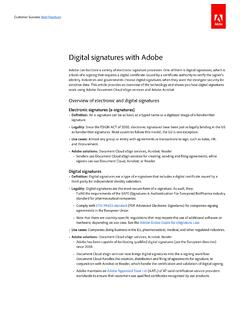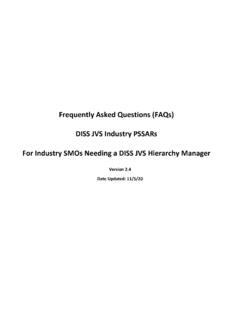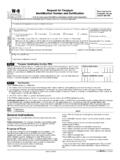Transcription of A.M. No. 01-7-01-SC July 17, 2001 RULES ON ELECTRONIC …
1 Republic of the Philippines SUPREME COURT Manila No. 01-7-01-SC July 17, 2001 RULES ON ELECTRONIC EVIDENCE Acting on the Memorandum dated 18 June 2001 of the Committee on the Revision of the RULES of Court to Draft the RULES on E-Commerce Law [ No. 8792] submitting the RULES on ELECTRONIC Evidence for this Court's consideration and approval, the Court Resolved to APPROVED the same. The RULES on ELECTRONIC Evidence shall apply to cases pending after their effectivity. These RULES shall take effect on the first day of August 2001 following thier publication before the 20th of July in two newspapers of general circulation in the Philippines 17th July 2001. RULES ON ELECTRONIC EVIDENCE Rule 1 COVERAGE Section 1. Scope. Unless otherwise provided herein, these RULES shall apply whenever an ELECTRONIC document or ELECTRONIC data message, as defined in Rule 2 hereof, is offered or used in evidence.
2 Section 2. Cases covered. These RULES shall apply to all civil actions and proceedings, as well as quasi-judicial and administrative cases. Section 3. Application of other RULES on evidence. In all matters not specifically covered by these RULES , the RULES of Court and pertinent provisions of statutes containing RULES on evidence shall apply. Rule 2 DEFINITION OF TERMS AND CONSTRUCTION Section 1. Definition of terms. For purposes of these RULES , the following terms are defined, as follows: (a) "Asymmetric or public cryptosystem" means a system capable of generating a secure key pair, consisting of a private key for creating a digital signature, and a public key for verifying the digital signature. (b) "Business records" include records of any business, institution, association, profession, occupation, and calling of every kind, whether or not conducted for profit, or for legitimate or illegitimate purposes.
3 (c) "Certificate" means an ELECTRONIC document issued to support a digital signature which purports to confirm the identity or other significant characteristics of the person who holds a particular key pair. (d) "Computer" refers to any single or interconnected device or apparatus, which, by ELECTRONIC , electro-mechanical or magnetic impulse, or by other means with the same function, can receive, record, transmit, store, process, correlate, analyze, project, retrieve and/or produce information, data, text, graphics, figures, voice, video, symbols or other modes of expression or perform any one or more of these functions. (e) " digital signature" refers to an ELECTRONIC signature consisting of a transformation of an ELECTRONIC document or an ELECTRONIC data message using an asymmetric or public cryptosystem such that a person having the initial untransformed ELECTRONIC document and the signer's public key can accurately determine: i.
4 Whether the transformation was created using the private key that corresponds to the signer's public key; and ii. whether the initial ELECTRONIC document had been altered after the transformation was made. (f) "Digitally signed" refers to an ELECTRONIC document or ELECTRONIC data message bearing a digital signature verified by the public key listed in a certificate. (g) " ELECTRONIC data message" refers to information generated, sent, received or stored by ELECTRONIC , optical or similar means. (h) " ELECTRONIC document" refers to information or the representation of information, data, figures, symbols or other modes of written expression, described or however represented, by which a right is established or an obligation extinguished, or by which a fact may be proved and affirmed, which is received, recorded, transmitted, stored, processed, retrieved or produced electronically.
5 It includes digitally signed documents and any print-out or output, readable by sight or other means, which accurately reflects the ELECTRONIC data message or ELECTRONIC document. For purposes of these RULES , the term " ELECTRONIC document" may be used interchangeably with " ELECTRONIC data message". (i) " ELECTRONIC key" refers to a secret code which secures and defends sensitive information that crosses over public channels into a form decipherable only with a matching ELECTRONIC key. (j) " ELECTRONIC signature" refers to any distinctive mark, characteristic and/or sound in ELECTRONIC form, representing the identity of a person and attached to or logically associated with the ELECTRONIC data message or ELECTRONIC document or any methodology or procedure employed or adopted by a person and executed or adopted by such person with the intention of authenticating, signing or approving an ELECTRONIC data message or ELECTRONIC document.
6 For purposes of these RULES , an ELECTRONIC signature includes digital signatures. (k) "Ephemeral ELECTRONIC communication" refers to telephone conversations, text messages, chatroom sessions, streaming audio, streaming video, and other ELECTRONIC forms of communication the evidence of which is not recorded or retained. (l) "Information and communication system" refers to a system for generating, sending, receiving, storing or otherwise processing ELECTRONIC data messages or ELECTRONIC documents and includes the computer system or other similar devices by or in which data are recorded or stored and any procedure related to the recording or storage of ELECTRONIC data messages or ELECTRONIC documents. (m) "Key pair" in an asymmetric cryptosystem refers to the private key and its mathematically related public key such that the latter can verify the digital signature that the former creates.
7 (n) "Private key" refers to the key of a key pair used to create a digital signature. (o) " public key" refers to the key of a key pair used to verify a digital signature. Section 2. Construction. These RULES shall be liberally construed to assist the parties in obtaining a just, expeditious, and inexpensive determination of cases. The interpretation of these RULES shall also take into consideration the international origin of Republic Act No. 8792, otherwise known as the ELECTRONIC Commerce Act. Rule 3 ELECTRONIC DOCUMENTS Section 1. ELECTRONIC documents as functional equivalent of paper-based documents. Whenever a rule of evidence refers to the term writing, document, record, instrument, memorandum or any other form of writing, such term shall be deemed to include an ELECTRONIC document as defined in these RULES .
8 Section 2. Admissibility. An ELECTRONIC document is admissible in evidence if it complies with the RULES on admissibility prescribed by the RULES of Court and related laws and is authenticated in the manner prescribed by these RULES . Section 3. Privileged communication. The confidential character of a privileged communication is not lost solely on the ground that it is in the form of an ELECTRONIC document. Rule 4 BEST EVIDENCE RULE Section 1. Original of an ELECTRONIC document. An ELECTRONIC document shall be regarded as the equivalent of an original document under the Best Evidence Rule if it is a printout or output readable by sight or other means, shown to reflect the data accurately. Section 2. Copies as equivalent of the originals. When a document is in two or more copies executed at or about the same time with identical contents, or is a counterpart produced by the same impression as the original, or from the same matrix, or by mechanical or ELECTRONIC re-recording, or by chemical reproduction, or by other equivalent techniques which accurately reproduces the original, such copies or duplicates shall be regarded as the equivalent of the original.
9 Notwithstanding the foregoing, copies or duplicates shall not be admissible to the same extent as the original if: (a) a genuine question is raised as to the authenticity of the original; or (b) in the circumstances it would be unjust or inequitable to admit the copy in lieu of the original. Rule 5 AUTHENTICATION OF ELECTRONIC DOCUMENTS Section 1. Burden of proving authenticity. The person seeking to introduce an ELECTRONIC document in any legal proceeding has the burden of proving its authenticity in the manner provided in this Rule. Section 2. Manner of authentication. Before any private ELECTRONIC document offered as authentic is received in evidence, its authenticity must be proved by any of the following means: (a) by evidence that it had been digitally signed by the person purported to have signed the same; (b) by evidence that other appropriate security procedures or devices as may be authorized by the Supreme Court or by law for authentication of ELECTRONIC documents were applied to the document; or (c) by other evidence showing its integrity and reliability to the satisfaction of the judge.
10 Section 3. Proof of electronically notarized document. A document electronically notarized in accordance with the RULES promulgated by the Supreme Court shall be considered as a public document and proved as a notarial document under the RULES of Court. Rule 6 ELECTRONIC SIGNATURES Section 1. ELECTRONIC signature. An ELECTRONIC signature or a digital signature authenticated in the manner prescribed hereunder is admissible in evidence as the functional equivalent of the signature of a person on a written document. Section 2. Authentication of ELECTRONIC signatures. An ELECTRONIC signature may be authenticated in any of the following manner: (a) By evidence that a method or process was utilized to establish a digital signature and verify the same; (b) By any other means provided by law; or (c) By any other means satisfactory to the judge as establishing the genuineness of the ELECTRONIC signature.






